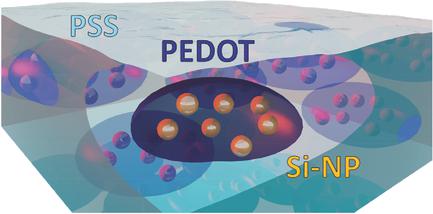当前位置:
X-MOL 学术
›
Adv. Electron. Mater.
›
论文详情
Our official English website, www.x-mol.net, welcomes your
feedback! (Note: you will need to create a separate account there.)
Morphology–Function Relationship of Thermoelectric Nanocomposite Films from PEDOT:PSS with Silicon Nanoparticles
Advanced Electronic Materials ( IF 5.3 ) Pub Date : 2017-07-04 , DOI: 10.1002/aelm.201700181 Nitin Saxena 1, 2 , Mihael Čorić 3 , Anton Greppmair 4 , Jan Wernecke 5 , Mika Pflüger 5 , Michael Krumrey 5 , Martin S. Brandt 4 , Eva M. Herzig 3, 6 , Peter Müller-Buschbaum 1, 2
Advanced Electronic Materials ( IF 5.3 ) Pub Date : 2017-07-04 , DOI: 10.1002/aelm.201700181 Nitin Saxena 1, 2 , Mihael Čorić 3 , Anton Greppmair 4 , Jan Wernecke 5 , Mika Pflüger 5 , Michael Krumrey 5 , Martin S. Brandt 4 , Eva M. Herzig 3, 6 , Peter Müller-Buschbaum 1, 2
Affiliation

|
The relation of the thermoelectric figure of merit and the nanocomposite morphology is studied for thermoelectric thin films consisting of poly(3,4‐ethylenedioxythiophene):poly(styrene sulfonate) (PEDOT:PSS) with different amounts of silicon nanoparticles (Si‐NPs). An increase in the figure of merit of up to 150% is found for an Si‐NP concentration of 0.5 wt% as compared to pristine PEDOT:PSS films. The improvement originates from a disruption in the molecular ordering and therefore reduced electrical conductivity, which leads to an increased Seebeck coefficient, while also reducing thermal conductivity for higher concentrations through phonon scattering. The thermal conductivity is measured with steady‐state IR thermography on free‐standing PEDOT:PSS/Si‐NP composite films, enabling a full determination of the figure of merit. The morphology is investigated with grazing incidence resonant tender X‐ray scattering (GIR‐TeXS) around the sulfur K‐absorption edge. Without need for extrinsic labeling, GIR‐TeXS measurements have varying scattering contrast conditions for the components of the ternary system. By comparing the scattered intensities at different photon energies with the corresponding scattering contrast, the Si‐NPs are found to be preferentially dispersed in the large and medium‐sized PEDOT‐rich domains. The changes in size for the PEDOT‐rich domains as function of Si‐NP concentration cause improvement of the thermoelectric properties of the films.
中文翻译:

PEDOT:PSS的热电纳米复合膜与硅纳米颗粒的形貌-功能关系
研究了由聚(3,4-乙撑二氧噻吩):聚(苯乙烯磺酸盐)(PEDOT:PSS)和不同数量的硅纳米颗粒(Si-NPs)组成的热电薄膜的热电性能因数与纳米复合材料形态的关系。 。与原始PEDOT:PSS膜相比,Si-NP浓度为0.5 wt%时,品质因数提高了150%。改善源自分子序的破坏,因此降低了电导率,这导致塞贝克系数增加,同时还通过声子散射降低了较高浓度时的热导率。通过在独立的PEDOT:PSS / Si-NP复合膜上进行稳态红外热成像测量热导率,从而全面确定品质因数。通过掠射入射共振硫X射线散射(GIR-TeXS)对硫K吸收边缘周围的形态进行了研究。不需要外部标记,GIR-TeXS测量对于三元系统的组件具有变化的散射对比度条件。通过将不同光子能量下的散射强度与相应的散射对比进行比较,发现Si-NPs优先分散在大中型PEDOT富集域中。富含PEDOT的区域的尺寸随Si-NP浓度的变化导致薄膜热电性能的改善。对于三元系统的组件,GIR-TeXS测量具有变化的散射对比度条件。通过将不同光子能量下的散射强度与相应的散射对比进行比较,发现Si-NPs优先分散在大中型PEDOT富集域中。富含PEDOT的区域的尺寸随Si-NP浓度的变化导致薄膜热电性能的改善。对于三元系统的组件,GIR-TeXS测量具有变化的散射对比度条件。通过将不同光子能量下的散射强度与相应的散射对比进行比较,发现Si-NPs优先分散在大中型PEDOT富集域中。富含PEDOT的区域的尺寸随Si-NP浓度的变化导致薄膜热电性能的改善。
更新日期:2017-07-04
中文翻译:

PEDOT:PSS的热电纳米复合膜与硅纳米颗粒的形貌-功能关系
研究了由聚(3,4-乙撑二氧噻吩):聚(苯乙烯磺酸盐)(PEDOT:PSS)和不同数量的硅纳米颗粒(Si-NPs)组成的热电薄膜的热电性能因数与纳米复合材料形态的关系。 。与原始PEDOT:PSS膜相比,Si-NP浓度为0.5 wt%时,品质因数提高了150%。改善源自分子序的破坏,因此降低了电导率,这导致塞贝克系数增加,同时还通过声子散射降低了较高浓度时的热导率。通过在独立的PEDOT:PSS / Si-NP复合膜上进行稳态红外热成像测量热导率,从而全面确定品质因数。通过掠射入射共振硫X射线散射(GIR-TeXS)对硫K吸收边缘周围的形态进行了研究。不需要外部标记,GIR-TeXS测量对于三元系统的组件具有变化的散射对比度条件。通过将不同光子能量下的散射强度与相应的散射对比进行比较,发现Si-NPs优先分散在大中型PEDOT富集域中。富含PEDOT的区域的尺寸随Si-NP浓度的变化导致薄膜热电性能的改善。对于三元系统的组件,GIR-TeXS测量具有变化的散射对比度条件。通过将不同光子能量下的散射强度与相应的散射对比进行比较,发现Si-NPs优先分散在大中型PEDOT富集域中。富含PEDOT的区域的尺寸随Si-NP浓度的变化导致薄膜热电性能的改善。对于三元系统的组件,GIR-TeXS测量具有变化的散射对比度条件。通过将不同光子能量下的散射强度与相应的散射对比进行比较,发现Si-NPs优先分散在大中型PEDOT富集域中。富含PEDOT的区域的尺寸随Si-NP浓度的变化导致薄膜热电性能的改善。











































 京公网安备 11010802027423号
京公网安备 11010802027423号